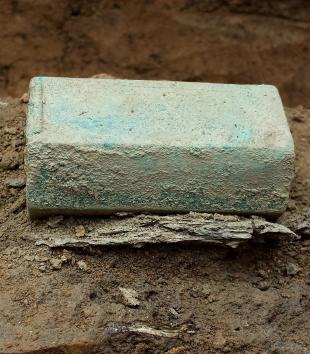The African American photographer James L. Allen (1907-1977) created this image of a black woman cradling a black infant in her arms during the 1930s (Fig. 1). Allen operated a studio in Harlem between 1926 and 1943 producing artistic and commercial photographs.1 During the Harlem Renaissance, mother and child portraits and figure studies were especially popular in the African American media, signaling the importance placed on motherhood and the nurturing of future generations. Celebrations of family reflected the sense of pride, community, and optimism that prevailed among African Americans during this period. This imagery also countered grotesque stereotypes that circulated globally by the beginning of the twentieth century.
In Allen’s photograph, the woman’s head is draped with a white fringed and striped shawl and framed with a circle of light that is paired with a star above her left shoulder indicating that the image denotes the Christian Madonna and Child represented as black figures. This was confirmed by the photograph’s reproduction on the cover of the December 1941 issue of Opportunity magazine, a periodical published by the National Urban League (Fig. 2). Black mother and child imagery likely always conjured the Marian icon for its audience, but the creation of a black version of the Madonna was deliberate for occasions like Christmas. Brown, black, and sepia Madonnas became a recurrent theme in African American visual culture of this period.
There is not much in the way of an iconographic precedent that Allen could have drawn upon for his representation of a black Madonna nor is there any real scholarship devoted to the depiction of a black Mary in African American culture. Studies of Christian religious imagery in African American art have generally focused on representations of Jesus or on scenes of baptisms, worship services, and visualized spirituals and sermon narratives.2 The portrayal of Jesus and other Christian scriptural figures as black embodied fundamental African American values and served to bolster African American self-esteem. Mary was regularly included in depictions of the Passion, particularly in Crucifixions or Pietas. Starting in the 1930s, the Annunciation also captured the imagination of artists, most notably Romare Bearden, who created several such scenes with African American protagonists. Still, the virtues of a virgin birth would have resonated strongly among African Americans, particularly women, who had been subject to a long history of sexual exploitation but were also conceived of as pathologically hyper-sexual in the white public imagination. Black versions of Mary from the Harlem Renaissance have not been studied in any real detail despite their proliferation in the visual culture of the period.
Although he never created a black Mary and often used his Swedish-American wife as his model, Henry Ossawa Tanner, who made a career as a religious painter, was one of the earliest African American artists to portray Mary.3 He selected The Annunciation as his 1898 submission to the French Salon (Fig. 3). This Mary was meant to embody a historically accurate vision of a Jewish woman. In Allen’s photograph, the Orientalist quality of the shawl that drapes his Madonna echoes Tanner’s ethnographic verism. In addition to biblical Palestine, in his Madonna and Child James L. Allen would also have been alluding to Egypt, Ethiopia, and other ancient African kingdoms. African American intellectuals had fashioned these kingdoms into a mythic past belonging to the descendants of enslaved Africans.4
The impetus for black Madonnas appear to have stemmed from the same social conditions that generated the cultural renaissance. In December 1919, for example, the African American photographer Cornelius M. Battey, who worked at the Tuskegee Institute (now University), created a black Madonna for the cover of The Tuskegee Student. A contemporary example that Allen would have known is Winold Reiss’s Brown Madonna. This image appeared as the frontispiece for The New Negro (1925), the publication considered to have defined the Negro Renaissance.5 Reiss, a white German émigré artist, also produced illustrations for a special “Harlem” issue of the Survey Graphic magazine and the expanded anthology that it inspired.6 Alain Locke, the African American philosopher who edited both publications, lauded Reiss for his “freshly conceived” imagery that did not perpetuate malicious caricature.7 Reiss's work designated an ordinary Harlem resident as the biblical icon. Her clothing was modern as were most mother and child images that circulated then. Allen's participation in the Harmon Foundation’s Negro art exhibitions would have familiarized him with the extant range of religious imagery created by African American artists and likely prompted his allusion to the historic Mary instead of a modern version.
By contributing to the development of a new racial iconography, Allen’s Madonna and Child and other black Madonnas offered positive visual and material rejoinders to widely reproduced images that represented black women’s failure to parent their own children. The Mammy stereotype, the legend of Margaret Garner (known as the Black Medea), and portraits of white children held by their black nannies belong to this latter and negative set of portrayals.8 A profile on Allen in Opportunity attests to the desire for affirmative visions of blackness:
Infinite variations of light and shade give to the portraits of James L. Allen a unique place of promise in the photographic arts. Though his work is not confined to the American Negro he sees in them an ideal of picturesque racial beauty heretofore undiscovered and unloved.9
Allen supplied an idealized rendition of a black Madonna and child using African American models. In doing so, he catered to the needs and desires of a community that was predominantly Christian and devout, but who, during their centuries-long presence in America, had been without religious icons that reflected and affirmed their own self-image.
Notes
1. Camara Dia Holloway, Portraiture & the Harlem Renaissance: The Photographs of James L. Allen (New Haven, CT: Yale University Art Gallery, 1999).
2. Kymberly N. Pinder, "'Our Father, God; our Brother, Christ; or We Bastard Kin?’: Images of Christ in African American Painting,” African American Review 31, no. 2 (Summer 1997): 223-233. doi:10.2307/3042461
3. Anna O. Marley, ed., Henry Ossawa Tanner: Modern Spirit (Berkeley, CA: University of California Press, 2012). For an essay discussing Tanner’s representation of Mary, see Daniel Burke, “Henry Ossawa Tanner’s La Sainte-Marie,” Smithsonian Studies in American Art 2, no. 2 (Spring 1988): 65-73. doi:10.1086/smitstudamerart.2.2.3108951
4. Renee Ater, “Making History: Meta Warrick Fuller’s Ethiopia,” American Art 17, no. 3 (Autumn 2003), 13-31. doi:10.1086/444622
5. Alain Leroy Locke, ed., The New Negro: An Interpretation (New York: Albert and Charles Boni, 1925).
6. Alain Leroy Locke, guest ed., “Harlem: Mecca of the New Negro,” The Survey Graphic 6, no. 6 (March 1925). For information about Reiss, see Jeffrey C. Stewart, To Color America: Portraits by Winold Reiss (Washington, DC: Smithsonian Institution Press for the National Portrait Gallery, 1989).
7. Alain Leroy Locke, “Harlem Types: Portraits by Winold Reiss,” The Survey Graphic, 651.
8. Leslie Furth, “’The Modern Medea’ and Race Matters: Thomas Satterwhite Noble’s Margaret Garner,” American Art 12, no. 2 (Summer 1998): 36-57. doi:10.1086/424319; Jo-Ann Morgan, “Mammy the Huckster: Selling the Old South for the New Century,” American Art 9, no. 1, (Spring 1995): 87-109. doi:10.1086/424235; Laura Wexler, "Seeing Sentiment: Photography, Race, and the Innocent Eye," Female Subjects in Black and White, eds. Elizabeth Abel, Barbara Christian, and Helene Moglen (Berkeley: University of California Press, 1997): 159-86.
9. “James L. Allen—Portraitist,” Opportunity (December 1928): 369.
Imprint
10.22332/con.obj.2014.44
1. Camara Dia Holloway, "James Latimer Allen, Madonna and Child," Object Narrative, in Conversations: An Online Journal of the Center for the Study of Material and Visual Cultures of Religion (2014), doi:10.22332/con.obj.2014.44
Holloway, Camara Dia. "James Latimer Allen, Madonna and Child." Object Narrative. In Conversations: An Online Journal of the Center for the Study of Material and Visual Cultures of Religion (2014). doi:10.22332/con.obj.2014.44





